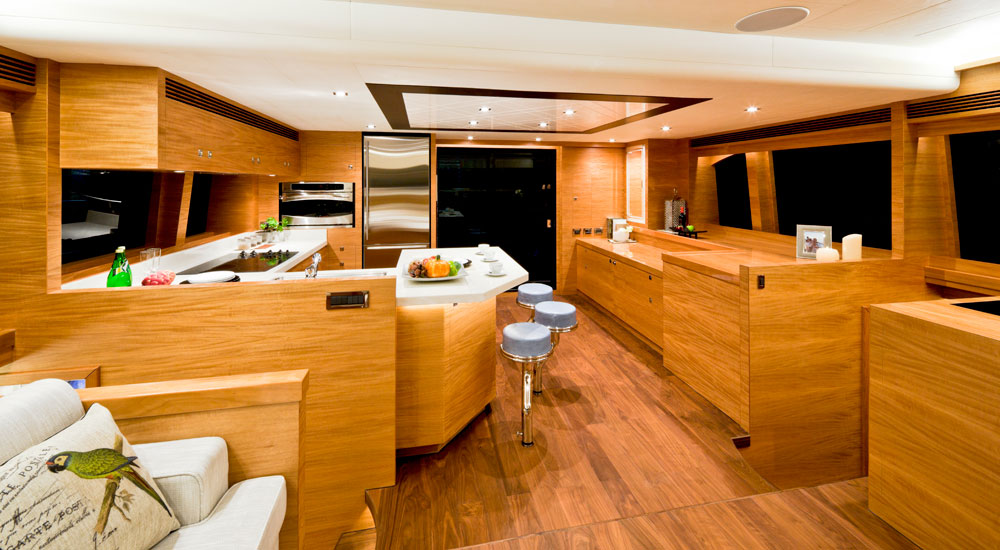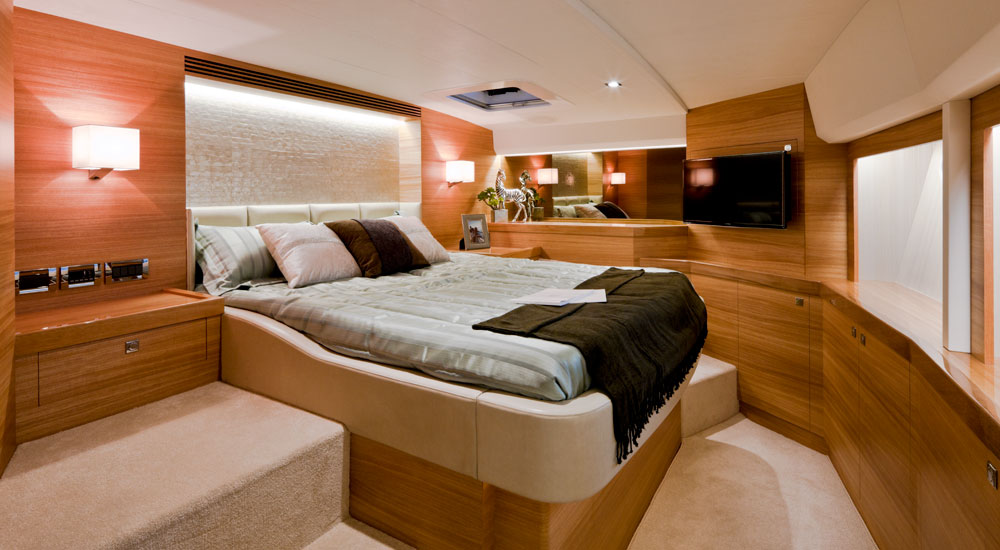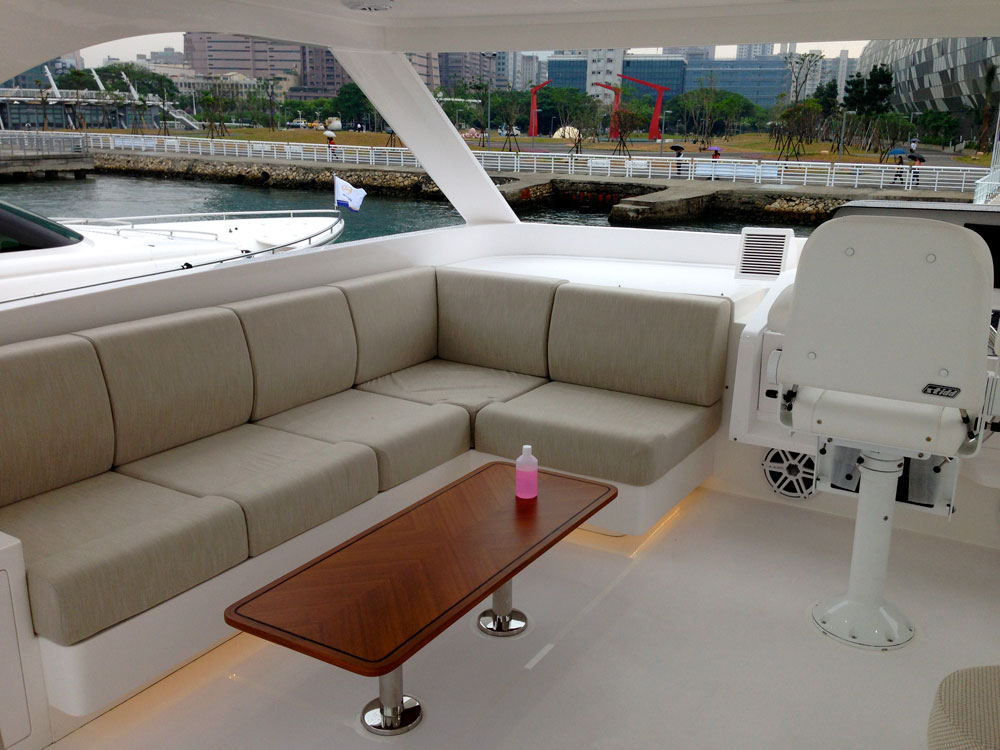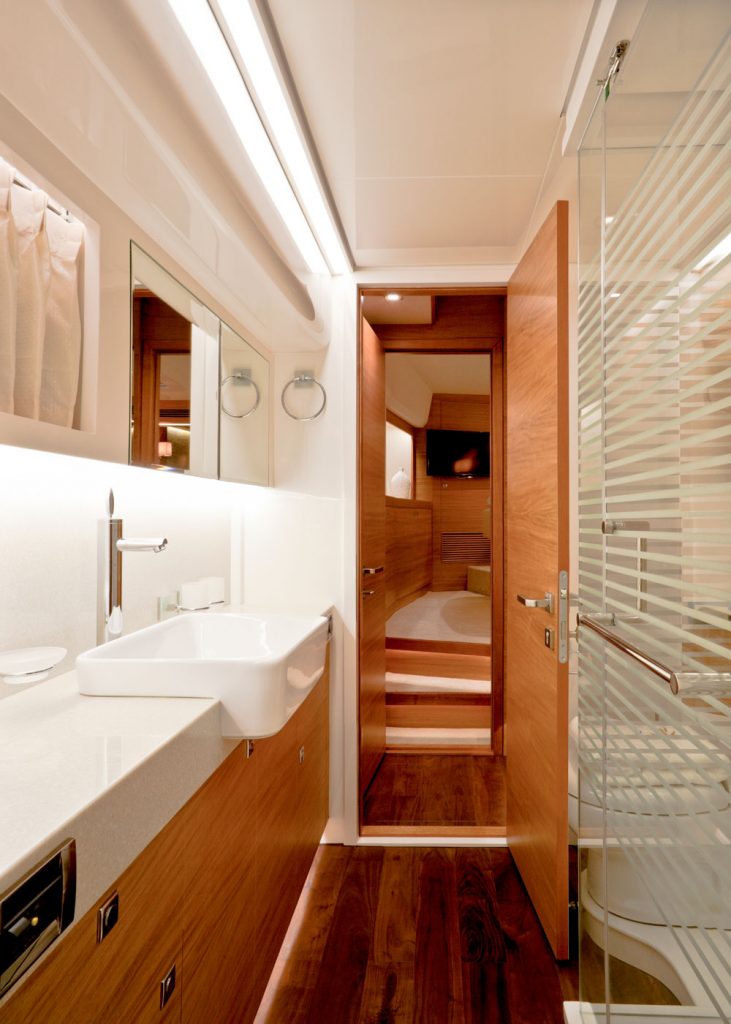The Horizon PC 52 is a luxury cruising cat with an affordable price tag that shares a lot of the same DNA as the Horizon PC60. Doug Dukeson went to Taiwan to check it out.
After the very successful release of the PC60 in 2012, the long anticipated little sister, the PC52 made its world debut at the inaugural 2014 Taiwan International Boat Show. The Horizon PC60 was the first model in the PC Series and has been extremely popular since its debut, with eight PC60 hulls already completed, two of those being sold to Australian owners. Fortunately, my attendance at the Taiwan show meant I was privileged to be one of the first to get onboard the new PC52.
The PC52 was built entirely to satisfy Horizon client’s continuous requests for a quality cat in the 50′ range. The first, Quintessence, viewed in Taiwan, is loosely based on the successful PC60 and will be delivered to its U.S. owners and make her U.S. debut at the 2014 Fort Lauderdale International Boat Show this October. The new Horizon PC52 model certainly answers the requests for a high-end power catamaran in the 50-foot range that is capable of true blue-water cruising, available in both open and enclosed flybridge versions.

Just as with the PC60, the PC52 is built with the same processes as all other Horizon boats, using their patented SCRIMP (Seeman Composite Resin Infusion Moulding Process) system and a 5 Axis CNC milling machine. This results in the vessel being both lighter and stronger than traditional build methods. The PC52 has been built more towards semi-production to ensure attractive pricing, although still with some flexibility in layout customisation.
On board at the time of my inspection, was Kiwi naval architect Angelo Lavarnos, who designed the hull and underwater sections, hull structure and the drivetrain, along with topside designer Stuart Hegerstrom, of the Powercat Company – who together, were the designers of the PC60. I joked about it being just a matter of reducing the plans on a photocopier… far from that it seems, with power cats being so weight sensitive there is a great deal of research and tank testing involved.
“This is what we refer to as a blue water cruiser,” Stuart Hegerstrom comments. “It’s been built towards a production style, with the goal being to create a top of the line luxury power cat with an attractive price tag – giving more people the opportunity to experience our award winning quality.”
The PC52 has been modeled after earlier Horizon power cats, and features a highly refined hull design developed from tank tests. The hull length to beam and slenderness ratios have been finely tuned to suit the requirements of the design and the shallow draft means this power cat is perfect for island hopping.
Just as with the PC60, the PC52 is built with the same processes as all other Horizon boats, using their patented SCRIMP (Seeman Composite Resin Infusion Moulding Process) system and a 5 Axis CNC milling machine. This results in the vessel being both lighter and stronger than traditional build methods. The PC52 has been built more towards semi-production to ensure attractive pricing, although still with some flexibility in layout customisation.

On board at the time of my inspection, was Kiwi naval architect Angelo Lavarnos, who designed the hull and underwater sections, hull structure and the drivetrain, along with topside designer Stuart Hegerstrom, of the Powercat Company – who together, were the designers of the PC60. I joked about it being just a matter of reducing the plans on a photocopier… far from that it seems, with power cats being so weight sensitive there is a great deal of research and tank testing involved.
“This is what we refer to as a blue water cruiser,” Stuart Hegerstrom comments. “It’s been built towards a production style, with the goal being to create a top of the line luxury power cat with an attractive price tag – giving more people the opportunity to experience our award winning quality.”
The PC52 has been modeled after earlier Horizon power cats, and features a highly refined hull design developed from tank tests. The hull length to beam and slenderness ratios have been finely tuned to suit the requirements of the design and the shallow draft means this power cat is perfect for island hopping.

From the Top
For a boat of this size, the PC52 has a huge flybridge area and interestingly the windscreen footprint around the bridge is designed to take either the open style with a bimini and clears or a fully enclosed flybridge, but with no structural changes needed for either option. The decision is completely up to the owner for the conditions they will be boating in. The standard helm is located on the flybridge, however an additional helm can be located in the main saloon if required. On Quintessential, the owner has opted for a desk where the helm could be positioned.
The skipper has a central helm position with expansive views. The large helm is well positioned with all instruments, controls and the Garmin electronics package close at hand and easily viewed.
Seating is abundant from the very comfortable Stidd helm chair, to the large forward facing sun pad and L shape lounge along the port side. When guests feel a little peckish or thirsty, there is a ‘kitchenette’ and large BBQ that backs onto the seating and bar area. To the aft of the flybridge a Steelhead davit is used to retrieve and launch a good sized tender that is stowed to the rear of the flybridge.

A staircase leads down to the lower cockpit, which sees a central lounge and table flanked by access either side to the individual hull boarding platforms. While a great open area for entertaining and relaxing, it is also well covered from the harsh UV rays with the top deck overhang that extends right through to above the transom. A fridge and wet bar mean you don’t have to go inside or back upstairs for refreshments.
Steps either side lead to the wide side decks for access to the foredeck area, where you’ll find deep anchor lockers and a Maxwell windlass, nicely concealed below deck level.
If you need to get into the engine or mechanical spaces, or extra storage space, there are big hatches either side in the cockpit sole.
Outstanding Saloon

Walking from the aft cockpit into the saloon I was certainly impressed with the spaciousness, with the u-shaped galley/bar situated starboard and bar stools lined up facing the generous counter space. Equipped with all the frills of a full home kitchen, such as a large microwave convection oven, a double drawer freezer, full-length fridge and dishwasher, the galley is ready for fine dining or casual entertaining. Being positioned aft in the main saloon it’s never too far to travel for a beer/wine or snack.
Walking past the galley there is a slight step up to the very open lounge area (the step providing extra headroom to the cabins below) and starboard side settee. When seated in the lounge, you can’t help but be impressed by the space around you. It’s huge and obviously something that is inherent of most powercats, where the internal beam is so much greater than that of an equivalent length monohull.
A drop down TV in a port side cabinet is also used to divide the entrances to the two port guest cabins. The lighter coloured anigre wood trim and soft toned fabric and upholstery gives the saloon an even larger and more spacious feel. Looking aft from the settee you feel you are very in touch with the chef cooking up a storm in the galley or those enjoying a cocktail at the bar. Certainly a saloon that offers plenty of room for dining, lounging and entertaining.
With the upper deck now all saloon, the actual area is, in fact, much the same as the PC60, albeit a little narrower, but at over 6m internal beam, it’s not noticeable. The compromise for all that space is the cockpit is a little shorter.

Accommodation Plus
Although when I first saw the PC60 and PC52 alongside each other I could quite easily see the size difference, it was interesting that when I stepped aboard the PC52 it was not so obvious. This, I found out after talking to Russell Wright, the Australian importer for the entire Horizon range is because the master stateroom is now down in the hulls and not on the main foredeck as in the PC60. Interestingly, in terms of area the master and en suite is probably very similar to the PC 60.
The entire starboard hull is devoted to the owner, with accommodation forward with a queen size athwartships berth with limited side access, dressing area with full height closets aft and an extra large bathroom to the rear. The ensuite includes a separate walk-in shower, custom carpentry, portlights for ventilation, plus a wooden sole and Corian countertops.
The VIP guest accommodation is found in the port side hull, where there are two cabins, each with their own access and separated by a shared head/ensuite.
The forward port guest cabin offers a full double berth, with the aft port cabin offering split twin berths with a walkway between. In the side-by-side twin single cabin, there is an infill that can convert this to a double if required.
Performance
Sea trials were carried out with full fuel and water, 12 people aboard and in a moderate sea off Kaohsiung Harbour. According to Russell, who had experienced both the PC60 & PC52, the ride and feel were very similar in the same conditions. I felt the hull had a nice rigid sensation and rode effortlessly in the shallow swells and with twin Cummins QSB 6.7 550hp engines returned an almost identical top speed to the PC 60 with a pair of 715hp Caterpillars.
Recent sea trials have recorded the PC52 offering a slow cruise of 8 knots; mid cruise of 17 knots and top speed of just over 22 knots.
When Barry Thompson reviewed the PC60, he said the ride and handling in the rough seas was “simply unbelievable”. He went on to say, “The PC60 would unquestionably be the best riding big powercat I have ever had the experience to run hard and fast in rough water”.
Russell added that he was confident that after running in the PC52 in moderate seas, that even taking into consideration the smaller dimensions of the PC52, it will perform exceptionally well in the sort of waters we get off the coasts of New Zealand and Australia. Based on the fact that designer, Angelo Lavranos was responsible for the underwater sections of both boats, I can’t see any reason to doubt him.


Cruising or Live Aboard
Russell comments – “While the PC52 design has optimised all the available space, we have remained mindful of weight saving to ensure she is a lively power catamaran, is easily driven and offers an efficient, soft, smooth, safe and comfortable ride”.
As we have seen with other Horizon models, everything that goes into building a Horizon Yacht contributes to its overall performance and high standards, right down to the smallest detail. Despite being 2.5m shorter and 0.75m narrower than the PC60, the PC52 doesn’t seem to miss out on much inside and is still huge compared to a similar length and even larger monohull.
I believe the new Horizon PC52 model answers the demand for a high-end power catamaran in the 50-foot range that has been requested by Horizon and potential owners. There’s also an AUD$1 million-price difference, between the PC52 and PC60, which is a significant factor in the buying equation.
Quintessence was the first of three PC52’s sold off the drawings, with a fourth heading down to Horizon Motor Yachts Australia, hopefully in time for the 2015 Sanctuary Cove Boat Show.
So where to from here for the PC range? Well, we have heard rumours of a PC76 already in the design stages. Watch this space!
- Boat Design Name: Horizon PC52
- Year Launched: 2014
- Designers: Angelo Lavarnos & Stuart Hegerstrom
- Interior Designer: Horizon Motor Yachts
- Builder: Horizon Motor Yachts
- LOA: 15.71m
- LWL: 14.05m
- Beam: 6.75m
- Draft: 1.29m
- Displ (loaded): 27.4 tons kgs
- Max Speed: 20.2 knots
- Cruise Speed: 16-18 knots
- Construction: GRP (SCRIMP)
- Fuel Cap: 3028 litres
- Water Cap: 946 litres
- Engines Make: Twin Cummins QSB 6.7/550HP
- Drive Train: Shaft
- Generator: Onan 13.5 KW (50Hz)
- Inverter/Charger: 3kw Victron
- Bow Thruster: Side power (optional)
- Anchor Winch: Maxwell
- Anchors: 50kg Delta
- Steering: Hydraulic
- Engine Controls: ZF Mathers Microcommander
- Lighting: 12V/240V LED
- Paint (Antifouling): International
- Wipers: Exalto 255BS (Skylounge version)
- Heads: 2 Tecma silence
- Woodwork: 22 different selections
- Upholstery: Choice of fabrics (leather option)
- Underwater Lights: Aqualuma
ELECTRONICS
- Autopilot: Garmin
- MFD: Garmin 15” touch screen plotter/sounder/24nm radar
- VHF: Garmin
- Ent System: Bose (option)
- Base Price of Boat: AUD$2,184,000 ex Gold Coast including GST
- Price As Tested: POA
FUEL & PERFORMANCE DATA | |||
Horizon PC52 Twin Cummins QSB 6.7/550HP | |||
Fuel 3028 litres | |||
Rpm | Knots | LPH | Range (nm) |
1400 | 5.6 | 21.6 | 639 |
1800 | 8.0 | 41.0 | 527 |
2200 | 10.7 | 69.2 | 439 |
2600 | 13.9 | 109.2 | 369 |
2900 | 16.5 | 143.8 | 336 |
3100 | 18.3 | 179.6 | 300 |
3300 | 20.2 | 220.6 | 272 |




